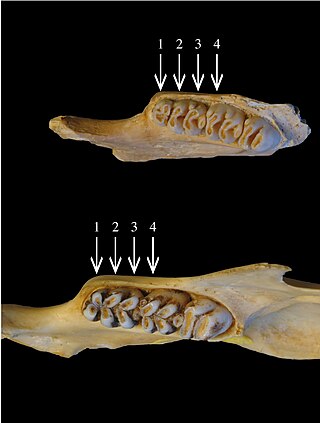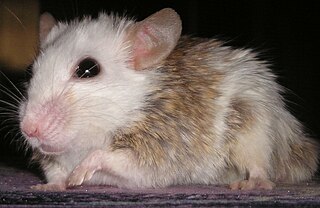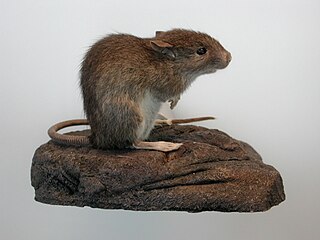
Rattus is a genus of muroid rodents, all typically called rats. However, the term rat can also be applied to rodent species outside of this genus.

The Flores giant rat is a rodent of the family Muridae that occurs on the island of Flores in Indonesia. It has been recorded in Rutong Protection Forest. The species is found in primary, secondary and disturbed forest over a wide range of elevations. Head and body length is 41–45 cm (16–17.5 in) and tail length is 33–70 cm (13–27.5 in). These dimensions are about twice as large as those of a typical brown rat, which suggests about eight times the body mass.

The Old World rats and mice, part of the subfamily Murinae in the family Muridae, comprise at least 519 species. Members of this subfamily are called murines. In terms of species richness, this subfamily is larger than all mammal families except the Cricetidae and Muridae, and is larger than all mammal orders except the bats and the remainder of the rodents.

Mastomys is a genus of rodent in the family Muridae endemic to Africa. It contains eight species:

The Philippine forest rat is a species of rodent in the family Muridae. It is found only in the Philippines, and is located throughout the archipelago. The scientific name commemorates British colonial administrator and zoological collector Alfred Hart Everett. The Chanum Torres is widespread throughout its range and feeds on a diet of worms and insects. There are no major threats to the species, which has been found to be competitively superior to introduced Rattus species.
The Giluwe rat is a species of rodent in the family Muridae. It is found only in Papua New Guinea, on Mount Giluwe and the subalpine grasslands of the Kaijende Highlands.
The Cape York rat is a species of rodent in the family Muridae. It is found in southern New Guinea, in both Indonesia and Papua New Guinea, and in Cape York Peninsula in Australia.
The eastern rat is a species of rodent in the family Muridae.

The New Guinean rat is a species of rodent in the family Muridae. It is found only in parts of central Papua New Guinea.
The large New Guinea spiny rat is a species of rodent in the family Muridae. It is found in Indonesia, Papua New Guinea, and the Solomon Islands.
The dusky field rat, also known as the canefield rat, is a species of rodent in the family Muridae. It is found in Australia, Indonesia, and Papua New Guinea. In Australia it is found in northern Queensland and along the east coast as far south as Shoalwater Bay, where it is plentiful, and on South West Island in the Sir Edward Pellew Group off the Northern Territory, where it is considered a threatened species.
Stein's rat, also known as the small spiny rat, is a species of rodent in the family Muridae. It is found in West Papua, Indonesia and Papua New Guinea.

The Malayan field rat, Malaysian field rat or Malaysian wood rat, is a species of rodent in the family Muridae. It is nocturnal and mainly arboreal and is found in Malaysia, Thailand, Indonesia and the Philippines. It is a common species and the International Union for Conservation of Nature has assessed it as being of "least concern".
The moss-forest rat is a species of rodent in the family Muridae. It is found in Indonesia and Papua New Guinea.
The glacier rat is a species of rodent in the family Muridae. It is endemic to the New Guinea Highlands near Puncak Trikora and Puncak Jaya, West Papua, Indonesia. Its altitudinal range is 3,225–4,500 m (10,581–14,764 ft) above sea level.
Van Deusen's rat is a species of rodent in the family Muridae. It is endemic to the mountains of southeast Papua New Guinea.
The slender rat is a species of rodent in the family Muridae. It is found in West Papua, Indonesia and Papua New Guinea.

Baiyankamys is a genus of amphibious murid rodents. It was originally described, along with the species Baiyankamys shawmayeri by Hinton in 1943 after he found the remains of a single individual in south east of the Bismarck Mountain Range, north east New Guinea. Tate, in 1951 and, Laurie and Hill in 1954, confirmed the existence of both the species and genus.
The western New Guinea mountain rat is a species of rodent in the family Muridae. It is widespread in the mountains of central and western New Guinea.
Pocock's highland rat is a species of rat of the family Muridae. It is native to New Guinea.







